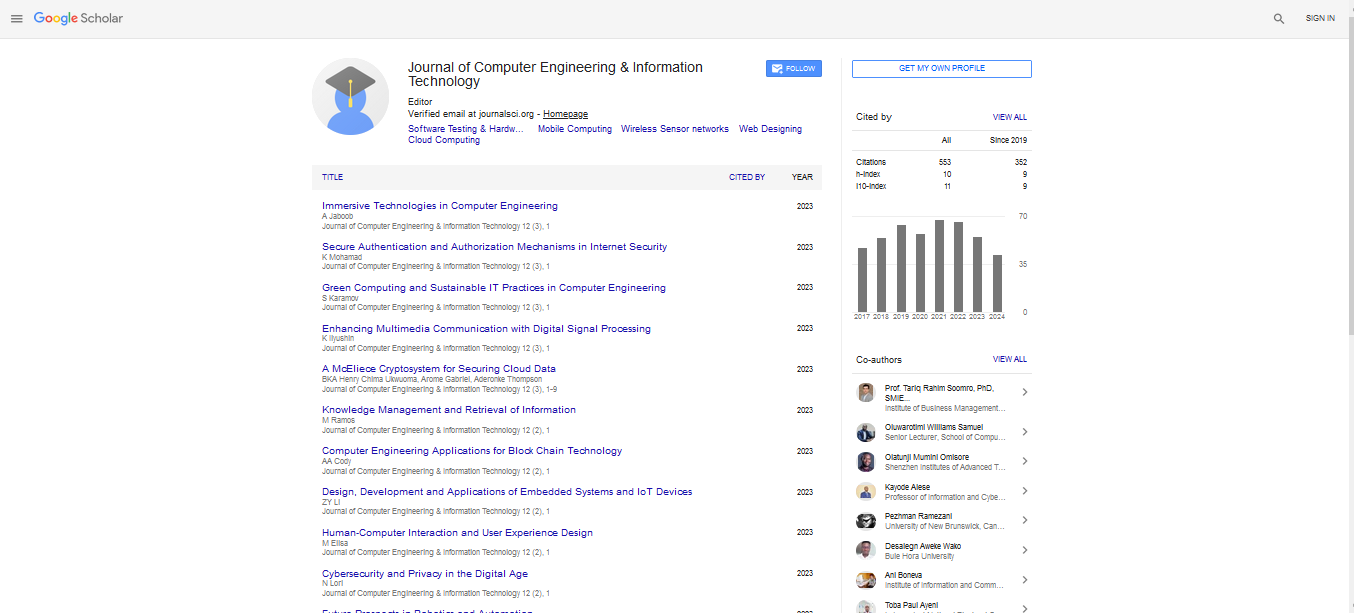Commentary, J Comput Eng Inf Technol Vol: 13 Issue: 4
Web Design and SEO: How to Enhance Search Engine Visibility
Li Yu*
1Department of Communication Sciences, Ghent University, Ghent, Belgium
*Corresponding Author: Li Yu,
Department of Communication Sciences, Ghent
University, Ghent, Belgium
E-mail: li.yu12@pku.edu.cn
Received date: 26 June, 2024, Manuscript No. JCEIT-24-143707;
Editor assigned date: 28 June, 2024, Pre QC No. JCEIT-24-143707 (PQ);
Reviewed date: 15 July, 2024, QC No. JCEIT-24-143707;
Revised date: 23 July, 2024, Manuscript No. JCEIT-24-143707 (R);
Published date: 31 July, 2024, DOI: 10.4172/2324-9307.1000313
Citation: Yu L (2024) Web Design and SEO: How to Enhance Search Engine Visibility. J Comput Eng Inf Technol 13:4.
Description
In today's digital age, having a well-designed website is essential for businesses and individuals alike. However, a visually appealing website alone is not enough to ensure success. To reach a broader audience and achieve business goals, it is essential to enhance the website's search engine visibility through effective Search Engine Optimization (SEO). This discuss the relationship between web design and SEO, and how integrating both can significantly improve search engine rankings and user experience. SEO refers to the practice of optimizing a website to improve its visibility on Search Engine Results Pages (SERPs). The primary goal of SEO is to attract organic (non-paid) traffic to a website by ensuring it ranks higher for relevant keywords and phrases. The importance of SEO can be summarized as follows.
Higher rankings on SERPs lead to increased visibility, which translates to more traffic and potential customers. Websites that rank higher are often perceived as more credible and trustworthy by users. SEO practices improve site usability and user experience, leading to higher engagement and satisfaction. Effective SEO can give businesses a competitive edge in their industry by outperforming competitors in search rankings. SEO involves several key elements that work together to improve a website's search engine visibility. Web design and SEO are inherently connected. A well-designed website that incorporates SEO best practices can significantly enhance search engine visibility. Here are some perilous aspects where web design and SEO intersect. With the increasing use of mobile devices, search engines prioritize mobile-friendly websites in their rankings. A mobile-first design approach ensures that a website is optimized for mobile users from the outset.
Implementing a responsive design ensures that the website adapts to different screen sizes and devices, providing a consistent user experience. Designing touch-friendly navigation and interactive elements enhances usability on mobile devices. Optimizing images, reducing server response time and imposing browser caching improve mobile loading speeds. Search engines consider user experience and usability as essential ranking factors. A well-designed website that offers a seamless and intuitive user experience is more likely to rank higher. Designing a clear and logical navigation structure helps user’s find information quickly and easily, reducing bounce rates. Creating visually appealing and engaging content, such as videos, infographics, and interactive elements, enhances user engagement and dwell time. Using legible fonts, appropriate font sizes, and sufficient contrast between text and background improves readability and accessibility. A well-organized site structure and architecture improve both user experience and search engine crawlability. Using descriptive and keyword-rich URLs helps search engines understand the content and improves user experience.
Implementing breadcrumb navigation aids user navigation and provides additional context to search engines. Creating and submitting Extensible Markup Language (XML) sitemaps ensures that search engines can efficiently crawl and index all important pages. Page speed is a acute factor for both user experience and SEO. Slow-loading pages can lead to higher bounce rates and lower search rankings. Compressing and optimizing images reduces load times without compromising quality. Minifying CSS, JavaScript, and HTML files reduces file sizes and improves loading speeds. Content Delivery Network (CDN) Using a CDN distributes content across multiple servers, reducing latency and improving load times for users globally. High-quality, optimized content is essential for both SEO and user engagement. Effective internal linking and navigation help users and search engines discover and navigate the website's content.
Creating a logical and hierarchical link structure improves navigation and distributes link equity across the site. Using descriptive and keyword-rich anchor text helps search engines understand the context of linked pages. Designing clear and user-friendly navigation menus improves usability and reduces bounce rates. Implementing schema markup and rich snippets enhances search engine understanding and can improve click-through rates. Using structured data markup helps search engines understand the content and context of web pages. Rich snippets, such as star ratings, reviews, and product information, enhance search results and attract more clicks. Integrating web design and SEO requires comprehensive approach that considers both aesthetic and functional aspects. Here are some best practices to achieve this integration.
 Spanish
Spanish  Chinese
Chinese  Russian
Russian  German
German  French
French  Japanese
Japanese  Portuguese
Portuguese  Hindi
Hindi 